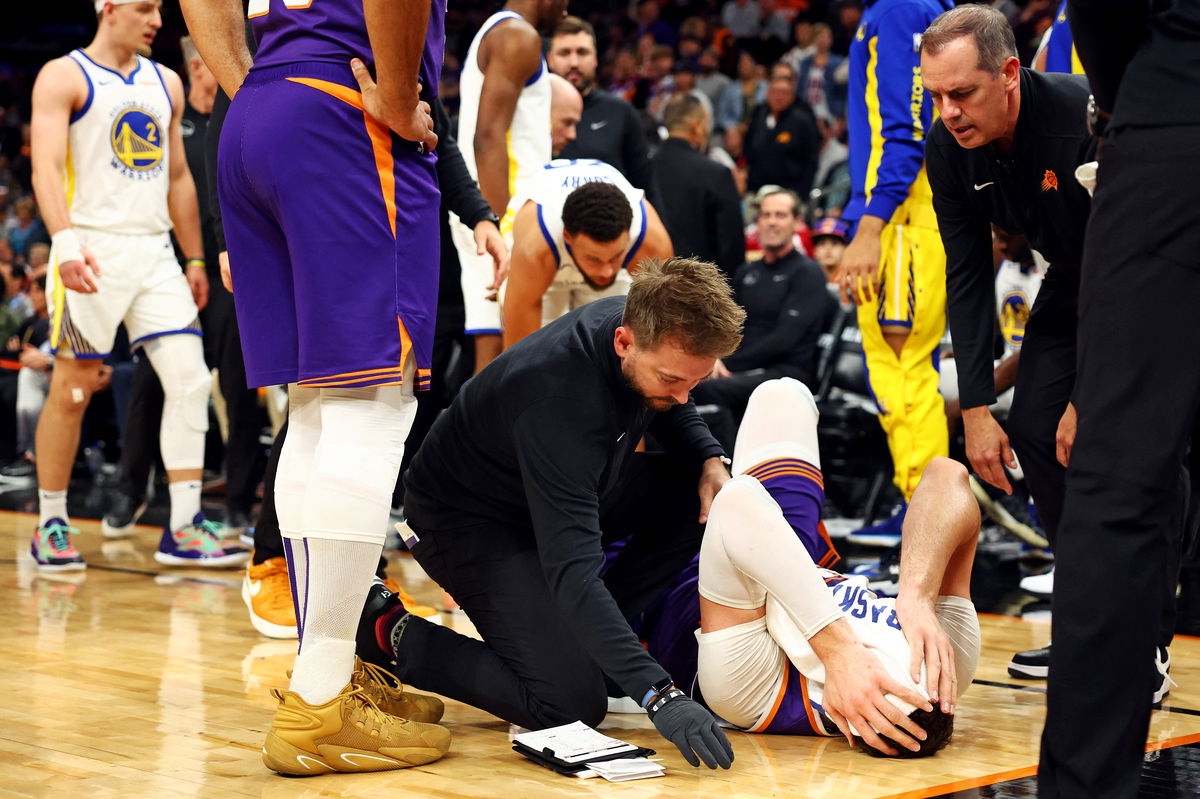
USA Today via Reuters
Dec 12, 2023; Phoenix, Arizona, USA; Phoenix Suns center Jusuf Nurkic (20) lays on the court after being fouled by Golden State Warriors forward Draymond Green (not pictured) during the third quarter at Footprint Center. Mandatory Credit: Mark J. Rebilas-USA TODAY Sports

USA Today via Reuters
Dec 12, 2023; Phoenix, Arizona, USA; Phoenix Suns center Jusuf Nurkic (20) lays on the court after being fouled by Golden State Warriors forward Draymond Green (not pictured) during the third quarter at Footprint Center. Mandatory Credit: Mark J. Rebilas-USA TODAY Sports
Given that this season is known more for the referees and fouls called rather than the brilliant matchups or remarkable players, we should take a deeper look into the fouls. The hot topic now is, of course, flagrant fouls, RE: Draymond Green throwing an arm or leg at every interval, or Dillon Brooks going off with no care has certainly increased the popularity of flagrant fouls.
Watch What’s Trending Now!
So what exactly is a flagrant foul? What are the different types of fouls in the NBA? Let’s take a look at each of them in detail!
ADVERTISEMENT
Flagrant foul – definition and determining factors
Any contact that is unnecessarily or excessively made against an opposing player constitutes a flagrant foul. To give you a visual idea, think of a groin hit, whack to the head, crashing an elbow into the chest, and so on. Pretty sure all these scenarios would have immediately brought to mind players who are notorious for such acts.

USA Today via Reuters
Dec 12, 2023; Phoenix, Arizona, USA; Golden State Warriors forward Draymond Green (23) reacts after being called for a foul on Phoenix Suns center Jusuf Nurkic (20) during the third quarter at Footprint Center. Mandatory Credit: Mark J. Rebilas-USA TODAY Sports
Depending on the severity, officials can assess two types of flagrant fouls to a player – flagrant fouls 1 and 2. The penalty for such an act is either free throws or an ejection. An ejection is usually given for a flagrant 2, as it is the worst. It is usually considered to be intentional or deliberate conduct. But whether it really can be perceived, so is up for debate. On the floor, though, the final say rests in the hands of the Crew Chief.
ADVERTISEMENT
Top Stories
Marina Mabrey Is Raising Eyebrows Again With Fiery Unrivaled Confrontation

Unrivaled Commissioner Makes His Opinion on Paige Bueckers Very Clear

Napheesa Collier Gives WNBA Fans Good Reason To Be Excited About Delayed CBA Conversations
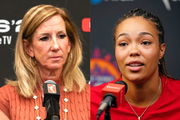
Steve Kerr Ejection vs Clippers: Stephen Curry, Draymond Green & Jimmy Butler Addresses Foul Controversy

NBA Refs Break Silence On Stephen Curry Foul After Warriors HC Steve Kerr’s Outburst

Flagrant 1 isn’t necessarily as severe, which is why when a flagrant 1 is called, it can result in two free throws and a turnover. The flagrant 2 also has the same penalty with immediate ejection. On the other hand, two flagrant 1 fouls in the same game automatically result in ejection. Of course, such decisions are reached only with appropriate replays and reviews while also considering a player’s previous record.
ADVERTISEMENT
Why don’t we move to the rest of the fouls that are a regular occurrence in the NBA?
A detailed look into personal fouls
If we cast aside the 2023-24 season, the more widely known type of foul is personal foul. This is a more grounded or subtle form of unnecessary personal contact by players. Assessing a personal foul largely depends on the referee officiating the game and, to a degree, might be subjective. They are further divided into two – offensive and defensive fouls. By a general rule of thumb, some fouls can be called on both.
ADVERTISEMENT
Offensive fouls
There are two that can come under this – Charge and Screen.
- A charge is often associated with dribblers. When a defending player takes his legal defensive position and a dribbler forces his way through the defender, it is considered a charge. The penalty for such a call is a personal foul and a turnover.
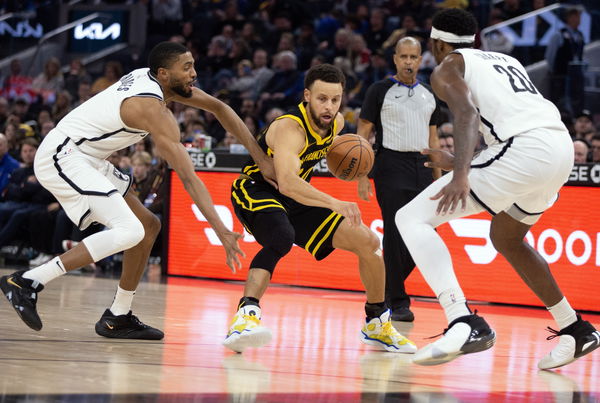
USA Today via Reuters
Dec 16, 2023; San Francisco, California, USA; Golden State Warriors guard Stephen Curry (30) controls the ball against Brooklyn Nets guard Mikal Bridges (1) and center Day’Ron Sharpe (20) during the second quarter at Chase Center. Mandatory Credit: D. Ross Cameron-USA TODAY Sports
- A screen is also a strategy employed by the offensive team, wherein a player with a ball or, in some cases without one, has another player standing in between them and a defender. Just as the name suggests, a screener “screens” or shields his teammate. When doing this, there are several ways an illegal screen can play out. Use of hands, extending arms or lower body, and leaning in can be called and assessed as an offensive foul. The penalty is losing possession of the ball and, in some cases, free throw. The officiating ref exercises their discretion to make a call for an illegal screen.
- A charge is often associated with dribblers. When a defending player takes his legal defensive position and a dribbler forces his way through the defender, it is considered a charge. The penalty for such a call is a personal foul and a turnover.
ADVERTISEMENT
Defensive Fouls
This category also has two types – Shooting fouls and Reach in
- Another one of the most common types of personal fouls, a shooting foul, happens when a defender gets in the way (through illegal contact) of a player trying to land a shot. Using means like grabbing, pushing, or even not giving enough space to land can be considered a shooting foul. The penalty for this is a free throw. The number of free throws depends on the exact moment a foul was called. A layup or mid-range shot warrants two free throws. A three-pointer gets three free throws. In the lucky event that a shooter manages to land the shot while being fouled, he gets one free throw on top of the basket.
- A reach-in is not a foul that one might find while coursing through the official NBA rules and regulations. But it occupies the same importance as the other fouls. In fact, some might even consider this as the top foul. A contact sport like basketball means there will be, well, contact. To put it simply, imagine you are going for a steal and the next thing you hear is a whistle. During this short period, the defender might unwittingly have initiated illegal contact, making the offensive player lose balance or hit any body parts. Usually, the penalty is a turnover, but in cases where there have been too many reach-in fouls, the ref might consider it prudent to award free throw(s).
- The final section in this is over the back and loose ball foul. This can be both defensive and offensive fouls.
- A loose ball foul is fairly straightforward. When a ball is not in possession of either team, players from both sides will look to get their hands on it. In the confusion, one or more players might be affected by illegal contact. The usual penalty is a possession of the ball, but in some instances, the fouled team might get free throws.
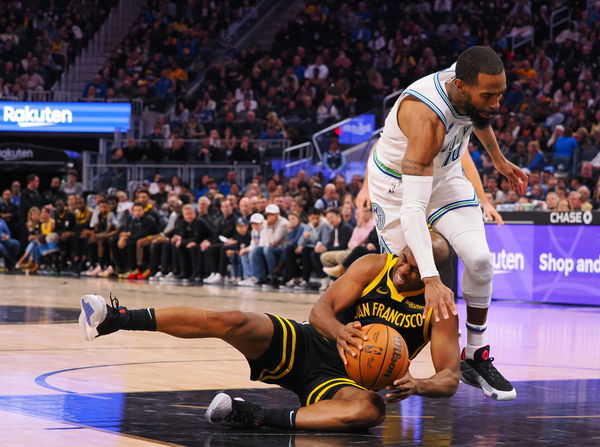
USA Today via Reuters
Nov 12, 2023; San Francisco, California, USA; Minnesota Timberwolves guard Mike Conley (10) fouls Golden State Warriors guard Chris Paul (3) as he dives for the loose ball during the fourth quarter at Chase Center. Mandatory Credit: Kelley L Cox-USA TODAY Sports
- Over the back foul happens in a rebounding situation. Whichever player is in the direct line to grab that rebound might jump ‘over the back’ of the player in front to get the ball. There might also be a bit of pushing the player directly in front to grab the rebound. So, depending on the player, the foul can be either offensive or defensive. Again, this is not something you can find in the rulebook, but it is a personal foul, nonetheless.
- A loose ball foul is fairly straightforward. When a ball is not in possession of either team, players from both sides will look to get their hands on it. In the confusion, one or more players might be affected by illegal contact. The usual penalty is a possession of the ball, but in some instances, the fouled team might get free throws.
ADVERTISEMENT
What is a technical foul?
The technical foul or simply tech has also gained popularity due to the Chris Paul-Scott Foster altercation. A technical doesn’t have any set rules as such to follow. Left in the hands of refs, it is their discretion that results in a call being made. A technical foul is a non-contact behavior or action that warrants a call.
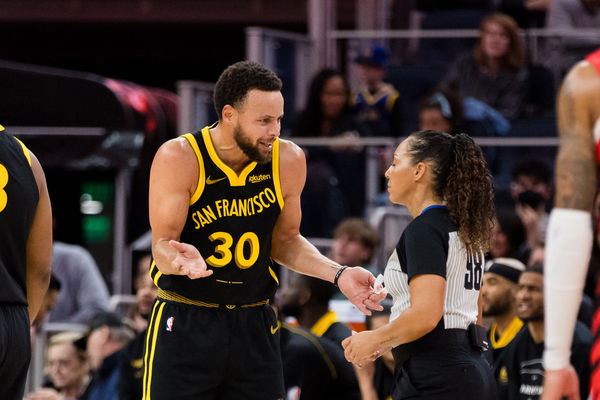
USA Today via Reuters
Dec 23, 2023; San Francisco, California, USA; Golden State Warriors guard Stephen Curry (30) argues with Official Sh’Rae Mitchell after a foul is called in favor of the Portland Trail Blazers during the second half at Chase Center. Mandatory Credit: John Hefti-USA TODAY Sports
It involves arguing with the officials, excessive celebration, a delay in the game, fights, a coach entering the court without permission, breaking the backcourt, more than (5+) or less than (-5) the required number of players on the court, using a racial slur or offensive language towards other players, and more.
ADVERTISEMENT
The penalty for a tech is a free throw for the opposing team. Each coach, player, and management personnel receive a limit of two technical fouls. Crossing the limit results in ejection. Technical fouls can be considered the most controversial of the lot.
From Luka Dončić, to Nikola Jokić to Draymond Green, the NBA this season has been the stage for some of the most unique calls made. So there you go! A detailed look into the fouls of the league. While fans and analysts are calling the NBA for getting too soft, this information can hopefully fill some gaps.
ADVERTISEMENT
Watch This Story: Chris Paul Annihilates Scott Foster After Controversial Call: “Don’t Use a Tech to Get Your Point Across”
ADVERTISEMENT
ADVERTISEMENT
ADVERTISEMENT

